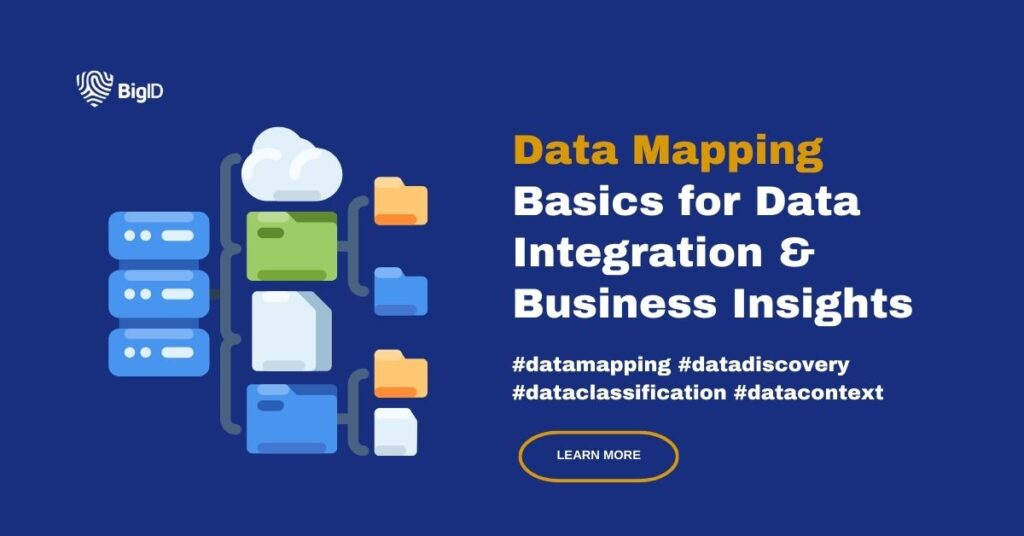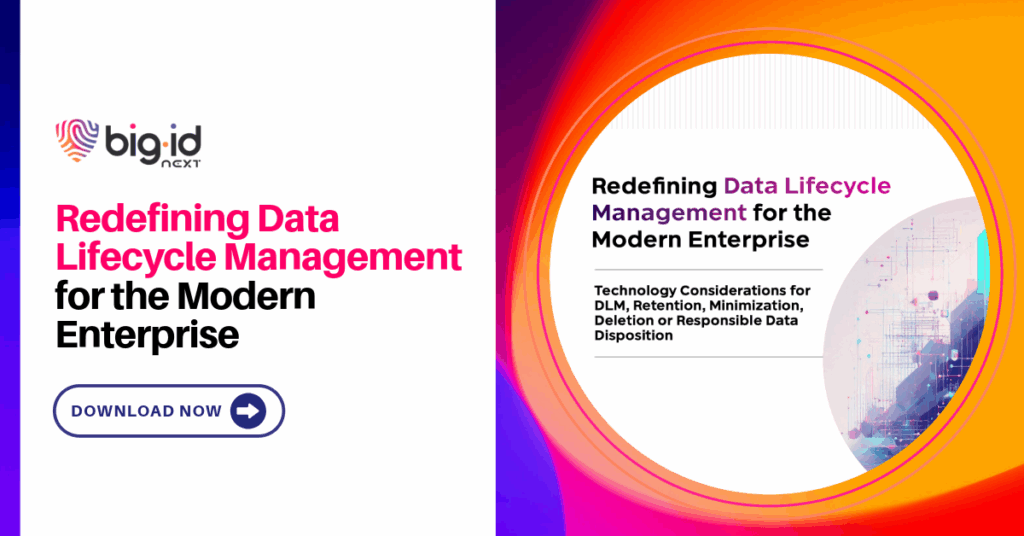Data is considered the modern-day oil, and the comparison isn’t just referring to value. Just like regulations define how fuel should be stored and used safely, there are laws for personally identifiable information (PII) and sensitive data as well.
The problem is, you can’t apply rules and policies to what you don’t know you have. To govern your data, you need to know where it’s stored, how it’s used, and how sensitive it is. That’s why data mapping is so important in governance and compliance.
What Is Data Mapping?
In governance, data mapping is the process of documenting your organization’s data ecosystem. It shows what PII you collect, where it’s stored, how data moves across systems, and how it’s used.
In short, data mapping creates visibility so that policies, compliance requirements, and security measures can be applied consistently.
Consider a retailer. To process an order, it needs:
- A customer’s name and address for delivery
- Their email for account confirmation
- A record of past purchases for marketing
Add employee records, supplier details, and financial transactions, and you can see how quickly data becomes complex.
A governance-focused map classifies these different types—public, personal, or sensitive—of data. It tells you how PII connects to business purposes and the legal basis for processing it.
With this unified view, you are better able to apply the right policies to your data. You can secure personal information and ensure it’s used only for legitimate purposes. You can also ensure that personal and sensitive data is retained or deleted in line with regulations such as the GDPR in the EU or the CCPA in California.
Additionally, advanced use cases like analytics or training AI models need accurate and consistent data. Mapping prepares your information for such purposes.
Enforcing privacy policies on data in itself is purely an intellectual exercise. Its practical application relies heavily on data mapping tools to ensure accuracy.
That’s what tells you where your data lives and how it moves within the data model. It classifies information according to its sensitivity. That, in turn, informs you of what policies to apply.
All in all, this process isn’t just a compliance exercise; it helps improve your data quality.
Key Benefits of Data Mapping for Governance and Compliance
Effective data mapping practices help your business in several ways, including improving data integration and analysis to better use data. Here are some of them:
Regulatory Compliance and Audit Readiness
The GDPR requires organizations to keep a record of how they use and process data. Granted, this is not required under other data protection laws, such as the CCPA and HIPAA. However, they too need you to know what personal data your business holds, why you process it, and how it moves.
Then there’s the fact that auditors and regulators don’t work on trust. You need to provide more than just your word that you’re following compliant data practices. A well-maintained data map is part of your detailed evidence. It helps you demonstrate and prove accountability.
Risk Reduction
Mapping highlights shadow data and shadow IT, which are databases, spreadsheets, or applications that operate outside approved systems. As you must’ve heard, ignorance of the law is not a defense for breaking the law. Similarly, not knowing you have data doesn’t mean you no longer have to follow regulations when storing or using it.
Identifying shadow data is the first step in bringing it under governance, and reducing the risk of data loss or breaches and the resulting fines.
Operational Efficiency
Knowing where your data resides and how it flows helps you avoid duplication and redundancy. Understanding the movement of data allows you to review your processes and reduce bottlenecks.
When collecting PII, you need to let data subjects access, review, or request deletion of their data. If you know where this data is stored, you can complete the DSAR more quickly and efficiently.
With all your data neatly organized, you are also less likely to have old or outdated information clogging up your storage space.
Support for DPIAs and RoPAs
Data Protection Impact Assessment (DPIA) is a process required under the GDPR for high-risk processing activities. It analyzes the risks PII faces during its use.
DPIAs and RoPAs (more on these later) rely on accurate data inventories and flow documentation. A data map makes these tasks faster, more accurate, and easier to maintain.
Improved Data Quality
Mapping is a great way to weed out inconsistent and redundant data. It requires you to consistently label it for context so it’s easily understood by machines. Clean, validated data not only strengthens compliance reporting but also ensures reliability for analytics and AI.
Vendor and Third-Party Oversight
Modern organizations depend on complex vendor ecosystems where data is shared to deliver more value to users. Mapping reveals how personal data is shared externally and assists in data transformation. It helps you verify that vendors apply the same standards of protection and meet contractual and legal obligations.
Cross-Border Compliance
Business data that crosses regulatory borders must be compliant across the board. For example, the GDPR states that PII belonging to EU residents can only be transferred to a country outside the European Union under specific circumstances.
If your business operates across multiple jurisdictions, a data map shows where data is transferred and stored. This tells you where to apply international transfer rules and maintain transparency with customers and regulators.
Of course, these benefits are only possible if you carry out the mapping process diligently.
Data Mapping Processes and Concepts
The process of data mapping can be roughly divided into two processes: inventorying data and creating a data map.
The inventory is a catalog of your data and its location, organized by sensitivity. The data map is a visual representation of why you need it and how it flows. Together, these two inform you on how to govern your business information.
To understand how data mapping works in governance, you need to understand some of its key concepts:
Data Types
A data map should track all kinds of information the business collects, including various data fields. That includes customer, employee, and business data.
Customer data includes (but isn’t limited to):
- Names
- Home/business/email addresses
- Phone numbers
- Payment information, such as credit card or banking details
- Order history
- Browsing history
Employee details can be:
- Contact details for HR records
- Payroll and banking information for salary payments
- Health and benefits enrollment details for insurance and compliance purposes
- Performance review results and training records to manage development and progression
- Emergency contact details for workplace safety requirements
Business information consists of various data sets:
- Contracts and agreements with vendors, partners, or clients
- Financial records such as invoices, ledgers, and tax filings
- Intellectual property, including product designs, source code, or research data
- Supply chain information, like shipping manifests or vendor pricing
Each bit of information may require varying levels of protection, depending on the applicable data privacy and industry-specific regulations.
Data Sources and Systems
Your organization collects data from a variety of touchpoints. Customer data might be collected and stored in CRM platforms, like Salesforce, or other marketing tools. Employee records might be in HR systems and data warehouses or payment processors.
You could have stored information in cloud storage, or even spreadsheets or legacy databases. These records might be equally varied in what format they are stored. Common data formats include SQL databases, JSON, XML, and CSV files.
The formats listed are all structured data sources. You might also have information stored in unstructured formats, such as emails, PDFs, and others.
Records of Processing Activities (RoPAs)
If your business is covered by the GDPR, you must maintain an internal log of your data processing activities under Article 30—a record of processing activities, in other words. This means that you should know what data assets your business owns, and how and why they’re used for internal purposes.
Data maps are essential for building and maintaining these RoPAs. They record what personal data is processed, for what purpose, under what lawful basis, and by whom.
Data Flows and Lineage
Your business collects PII for a purpose, so it never sits in a database doing nothing. It must flow through systems and applications to fulfill its purpose.
Mapping in governance shows how data travels from source to destination, whether internally between applications or externally to vendors.
It documents the lineage so you don’t have any blind spots. Additionally, it helps you identify shadow data or shadow IT by comparing your data inventory against your system requirements.
Policies and Controls
Any data you collect is bound by certain rules. Data governance policies cover why you need the information, how to destroy it once its purpose is met, and everything in between.
Under the GDPR, you need a lawful basis to process information. While consent is one of them, it’s not the only one. Other bases are contractual necessity, legal obligation, vital interests, public tasks, and legitimate interests.
Every data element in a governance map should be linked to the lawful basis as well as its business purpose to effectively leverage data. For example, you might need it to “fulfill an order” or “manage payroll.” Documenting the purpose and basis ensures accountability and makes it easier to understand data compliance during audits.
Now that you’ve collected personal and sensitive information, you need to safeguard it using adequate security and privacy protection measures. This data should be encrypted in storage and during transmission. Access to it should be restricted to those who are authorized to view it.
Also, you can’t retain personal data indefinitely. It must be destroyed once its purpose is served. Your data policies must include the deletion triggers and instructions on how to dispose of the information safely.
Metadata
Data points by themselves are meaningless. Metadata—data about data—provides the context that makes a map usable. It explains what each data element is, where it came from, how it’s classified, and who owns it, which is vital for data management.
Metadata is an essential part of data mapping and data structures. Without it, you just have a bunch of fields that don’t mean anything. Plus, it’s not just useful for mapping data; Metadata is also essential if you want to use your business information to train AI or for analytics.
Data Quality and Validation
Over time, your business data can “degrade.” You might change formats, making older entries inconsistent with the new ones. Different departments might make copies for their own use, leading to multiple versions of the same information. Certain old records that aren’t needed anymore but haven’t been deleted add to the clutter (and your risk).
Data mapping helps improve quality by flagging inconsistent data, redundancies, and outdated records. Clean, validated data is easier to govern. It also makes for accurate reporting, analytics, and AI training.
Data Mapping Techniques
There is no one way to map your data, and the best way might depend on the size of your organization and the complexity of your data ecosystem. In general, mapping can be broadly approached in three ways:
Manual Mapping
Organizations without automated tools often rely on manual methods. They may use anything from spreadsheets and flow diagrams to structured questionnaires that business units or vendors complete. Manual approaches are cost-effective and flexible. They’re also time-consuming to maintain and often miss hidden or shadow data.
Hybrid Mapping or Semi-Automated Mapping
Many organizations combine manual and automated techniques. Automated tools highlight where data resides and how it flows. Then, the teams add the context that technology can’t infer on its own. This hybrid approach balances efficiency with data accuracy.
Automated Mapping
Automated tools don’t need much manual intervention. They use metadata analysis, pattern recognition, and increasingly AI/ML to discover and classify data across cloud, SaaS, and on-premises environments. You get a real-time view of personal and sensitive data. That makes it easier to keep inventories current, support audits, and meet compliance deadlines.
Automated mapping reduces human error. It also scales easily with your business, as its environment becomes more complex.
Automating Data Mapping With BigID’s Data Intelligence Platform
BigID automatically discovers and classifies sensitive data across structured, unstructured, and cloud environments. The platform builds RoPAs, supports DPIAs, and maps data flows—including shadow data—so you can stay compliant, reduce risk, and simplify governance.
But that’s not all it does. The platform gives you everything you need to manage your data, including discovery and classification, access and security, and more.
Interested in finding out how BigID can help your business data? Schedule a demo today.



